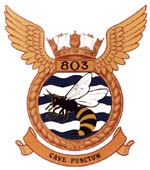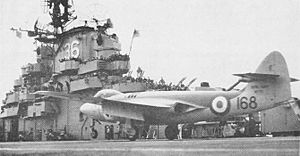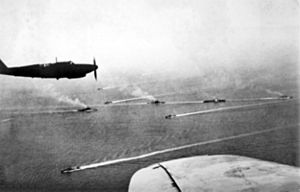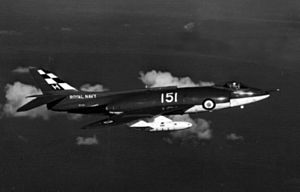803 Naval Air Squadron facts for kids
Quick facts for kids 803 Naval Air Squadron |
|
|---|---|

803 Naval Air Squadron crest
|
|
| Active | 3 April 1933 – 1 October 1937 21 November 1938 – August 1941 March 1942 – August 1943 June 1945 – January 1946 (RN) January 1946 – 1 May 1951 (RCN) 1953 – 1957 (RN) 1958 – 1 October 1966 3 July 1967 – 18 December 1969 |
| Country | |
| Branch | |
| Role | Fighter squadron |
| Part of | Fleet Air Arm |
| Motto(s) | Cave Punctum (Latin for "Beware of the sting") |
| Anniversaries | none |
| Battle honours | North Sea 1939 Norway 1940 Libya 1940–41 Matapan 1941 Crete 1941 Mediterranean 1941–44 |
The 803 Naval Air Squadron was a special group of pilots and planes in the Royal Navy's Fleet Air Arm. They flew different types of aircraft, mostly fighter planes, during important times in history, including World War II.
Squadron History
Early Years: Before World War II
The 803 Naval Air Squadron first started on 3 April 1933. It was formed from an older group called No 409 (Fleet Fighter) Flight. They had nine Osprey planes.
In April 1933, the squadron sailed to the Far East on a ship called HMS Eagle. They stayed there for a few years, moving to HMS Hermes in January 1935. The squadron was then stopped on 1 October 1937.
But the 803 Squadron was started again on 21 November 1938. This time, they were based at RNAS Worthy Down. They started with six Ospreys and three Nimrod planes. Later, in December 1938, they got six Skuas and three Nimrods. In April 1938, the squadron went aboard HMS Ark Royal. At first, they were part of the Royal Air Force (RAF), but in May 1939, they became part of the Navy.
World War II Operations
When World War II began, the 803 Squadron was on HMS Ark Royal. They flew Skua and Roc planes.
Fighting in the North Sea and Norway
The squadron flew from Scapa Flow in Scotland. They looked for enemy submarines in the Northwestern Approaches. On 14 September 1939, they attacked a German submarine, U-30, but lost two of their Skua planes. They also protected a ship called SS Fanad Head.
The squadron also flew patrols near Norway. On 26 September 1939, they shot down a Dornier 18 plane. This was the first German aircraft shot down by a British plane in the war! In April 1940, they continued their work in Norway from HMS Glorious.
Sinking the Königsberg
The 803 Squadron, along with 800 Squadron, successfully dive-bombed and sank the German cruiser German cruiser Königsberg at Bergen. This was a big victory. However, an attack by 803 Squadron on the German battleship German battleship Scharnhorst in June was not as successful. Most of their planes were lost.
Battles in the Mediterranean
In October 1940, the 803 Squadron was started again with new Fairey Fulmar I planes. They served in the Eastern Mediterranean on HMS Formidable. They fought in the Battle of Cape Matapan, where they shot down two enemy planes and damaged two more. They also helped protect ships bringing supplies to Malta and helped with the evacuation during the Battle of Crete.
After HMS Formidable was damaged at Crete, the 803 Squadron moved to Dekheila. There, they got new RAF Hurricane planes. From June 1941, they were based in Palestine and flew missions against Syria. In August 1941, they joined another group called the RN Fighter Squadron, which fought in the Western Desert.
Operations in Asia and Africa
In March 1942, the squadron got new Fairey Fulmar II planes. They flew from Ceylon (now Sri Lanka) against the Japanese, including during the Easter Sunday Raid. In April, they rejoined HMS Formidable in the Indian Ocean.
In 1943, the 803 Squadron operated in East Africa. They then combined with 806 Squadron for army training exercises. The combined squadron was stopped in August 1943.
The squadron was started again in June 1945. They were ready to join the 19th Carrier Air Group in the Far East. They were based at Arbroath and had 25 Seafire L.III planes. But just as they were about to leave in August 1945, the war ended on VJ Day.
After World War II
Serving with Canada
In January 1946, the ship HMS Warrior was given to the Royal Canadian Navy and renamed HMCS Warrior. The 803 Squadron went with the ship. In May 1951, the squadron was renamed 870 Squadron RCN. This meant the name "803 Squadron" was available for the Royal Navy again.

New Planes and Final Years
The 803 Naval Air Squadron was started again in 1958. They became the first squadron in the Fleet Air Arm to fly a plane that could carry nuclear weapons, the Supermarine Scimitar F.1. Eight years later, they were also the last front-line squadron to use the Scimitar.
The squadron flew from the newly rebuilt ship HMS Victorious for two years. Then they moved to HMS Hermes for another two years. During this time, they usually had eight planes. After that, they moved to HMS Ark Royal. This ship had more space, so the squadron could have 16 planes. This happened when they took in 800 NAS. The 803 Squadron was stopped again on 1 October 1966. Their Scimitar planes were moved to RNAS Brawdy in Pembrokeshire.
The 803 Naval Air Squadron was started one last time on 3 July 1967. They were based at RNAS Lossiemouth and helped test the Buccaneer S.2 plane. In August 1968, the squadron showed that the Navy could send planes quickly to ships far away. Four of their Buccaneer planes flew from Britain to the Indian Ocean to join Hermes.
After the government decided to make the British carrier force smaller, the 803 Naval Air Squadron was stopped for good on 18 December 1969. Their planes were given to the Royal Air Force.
World War II Battle Honors
These are the important battles and campaigns where the 803 Naval Air Squadron played a key role:
- North Sea 1939
- Norway 1940
- Libya 1940–41
- Matapan 1941
- Crete 1941
- Mediterranean 1941–44
Aircraft Flown
The 803 Naval Air Squadron flew many different types of aircraft over the years:
- Hawker Osprey (1932–1944)
- Hawker Nimrod (1933–?)
- Blackburn Skua II (December 1938 – October 1940)
- Blackburn Roc I (April 1939 – April 1940)
- Fairey Fulmar I (October 1940 – June 1941)
- Hawker Hurricane I (June 1941 – March 1942)
- Hawker Sea Hurricane (June 1942 – August 1942)
- Fairey Fulmar II (March 1942 – August 1943)
- Supermarine Seafire III (June 1945 – end of WW2)
- Supermarine Seafire F.XV (August 1945 – end of WW2)
- Supermarine Attacker FB.2 (January 1953 – May 1954)
- Hawker Sea Hawk (1953–1957)
- Supermarine Scimitar (1958–1966)
- Blackburn Buccaneer (1967–1969)



